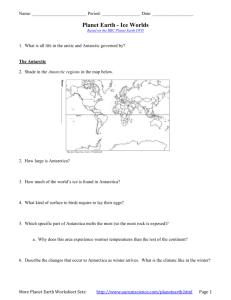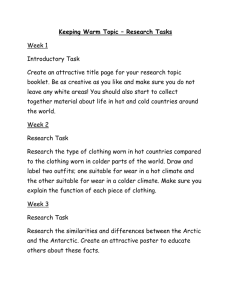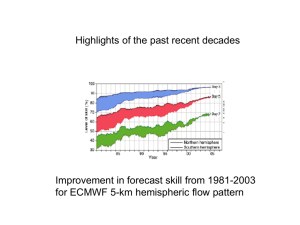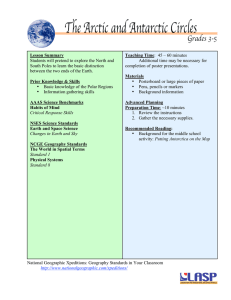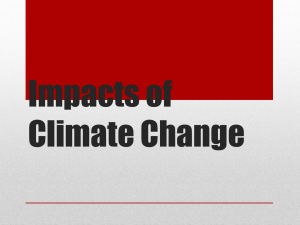Opportunities for Research at the Ends of the Earth NSF Research Day
advertisement
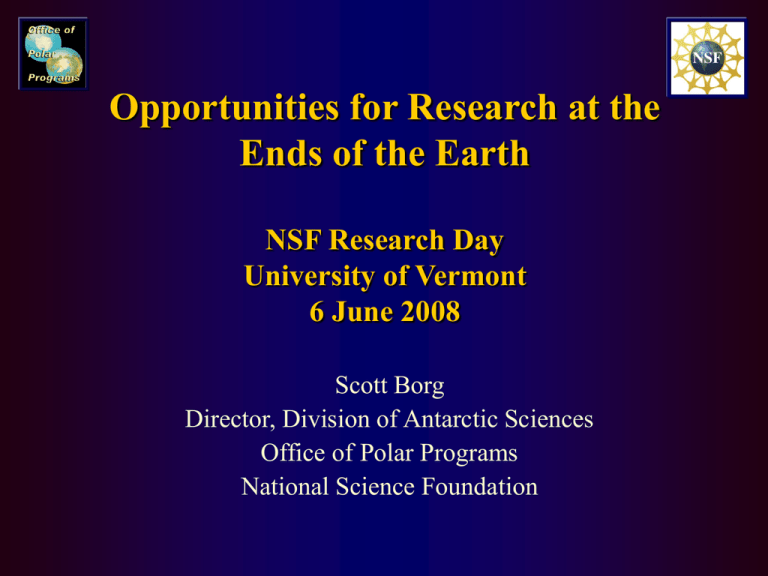
Opportunities for Research at the Ends of the Earth NSF Research Day University of Vermont 6 June 2008 Scott Borg Director, Division of Antarctic Sciences Office of Polar Programs National Science Foundation Office of Polar Programs • Only part of NSF with a geographical focus • OPP science is a microcosm of NSF • Broad array of single investigator and small group research opportunities in many disciplines • Interdisciplinary collaborative research is a strength and an emphasis • Strong ties with other agencies, other directorates within NSF, and with international partners • National roles in both polar regions Office of Polar Programs Office Director and Executive Officer • Division of Arctic Sciences • 3 research programs along with science support and logistics • Division of Antarctic Sciences • 6 research programs, artists/writers program • Division of Antarctic Infrastructure and Logistics • 3 stations, 2 RV’s, supply systems, airplanes, helicopters, vehicles, labs, science support, etc • Office of Polar Environment, Safety and Health • Policy, management plans, etc Arctic Opportunities National Role for NSF: • Coordinating federal Arctic research investments Research Programs: • Arctic Social Sciences • Arctic Natural Sciences • Arctic System Science Solicitations: • Arctic Research Opportunites (general) • Bering Ecosystem Study • Western Arctic Shelf-Basin Interactions • Polar Postdoctoral Fellowships Arctic Opportunities Examples of Emphasis Areas • Arctic Languages and Culture • SEARCH – Study of Environmental Arctic Change • AON – Arctic Observing Network, IPY effort • build and exploit this system • ocean/land/atmosphere components • will facilitate SEARCH Language and Culture: 21st Century Arctic Adaptations, Beyond IPY • Documenting Endangered Languages. • Exploring New Evidence of Arctic Migrations. • Interdisciplinary Research Exploring Social and Cultural Adaptations to the Changing Arctic Environment. Image: Shari Gearheard SEARCH: To understand causes of arctic climate variability and responses of the arctic system to changes Recent retreat of Helheim Glacier – Image : NASA Earth Observatory Increased shrub growth Image: M. Sturm Decreased Sea ice extent 25 Sept 2007 Image: NSIDC Arctic Observing Network: Physical & Chemical Oceanography; Sea Ice Bering Strait Aerial Hydrographic Surveys North Pole Environmental Observatory Seasonal Ice Zone Beaufort Gyre Observatory & Deepest Waters Ice-Tethered Profilers & Ice Dynamics and Weather Buoys Davis Strait Switchyard & Seasonal Ice Zone Arctic Opportunities Research Facilities • Toolik Lake Field Station – operated by UAF • USCG Ice Breaker Healy • Logistics and science support contractor • Ice Coring and Drilling Services contract • Small plane and helicopter charters • International Partnerships – for instance… • Oden other ships in Arctic • Lab in Svalbard Turning South Antarctic Research National Role for NSF: Single point manager of the Nation’s investments in Antarctic activities – expressed through science Research Programs: • • • • • • Antarctic Aeronomy & Astrophysics Antarctic Earth Sciences Antarctic Glaciology Antarctic Integrated System Science Antarctic Ocean and Atmospheric Sciences Antarctic Organisms and Ecosystems Solicitations • Antarctic Research (general) • Polar Postdoctoral Fellowships Antarctic Opportunities New Knowledge about the Antarctic, including • exploration/discovery, and • how it interacts with the non-polar Earth system Antarctica as a Platform for Research • Astronomy/Astrophysics • Seismology of the deep interior Examples of Emphasis Areas: • Oceanographic changes with global change/warming • ocean acidification, carbon cycle, sea ice and ice shelf interaction • Changing Cryosphere and its contribution to sea level rise • Exploit discovery potential of IceCube and 10m SPT • Solar/Terrestrial Physics: internationally collaborative observation networks and research exploitation Amundsen-Scott South Pole Station, Dedicated Jan 2008 South Pole Astrophysical Observatories In red - approximate instrumented volume, e.g. 40 of the planned 70-80 strings. μ Science requirement: 1 km3 detector volume 10m South Pole Telescope – search for Dark Energy and Dark Matter Science Exploitation is Underway! → Ice Cube Neutrino Observatory – new window on the universe Solar/Terrestrial Physics: Ionospheric Research NIPR LPM between Syowa & Dome F Syow a Dom eF Dom eA Virginia Tech LPM test run at South Pole ZH S Palmer Station and Marine Research Life in the Cold and Dark Algal mats in ice-covered lakes Rich and diverse marine life Fish antifreeze proteins Bacteria Found in snow at the geographic South Pole Life within rocks Effect of elevated CO2 on shell formation, physiological function, and ecological interactions among planktonic pteropods • Elevated CO2 in the southern ocean may cause significant carbonate undersaturation within the next 50-100 years • Pteropods, other shell bearing organisms at risk • Physiological, bioenergetic and food web consequences for pelagic organisms and ecosystems Limacina helicina Clione antarctica McMurdo Station and Remote Interior Research Mars Analogs Surface morphology – Upper Beacon Valley, Antarctica 1 km Debris-covered glaciers from Antarctica’s Dry Valleys Upper Beacon Valley 1 km Mars crater wall 247 W / 38 S M18/00898 Interior crater wall on Mars – Viscous flow? Dave Marchant and Jim Head ANT – New Initiative AISS Workshop Report http://cresp.tamu.edu/AISSWorkshop attended by 40 scientists representing broad spectrum of earth & environmental research fields, institutions and career stages Now a new program area. Antarctic Ice Sheet & Climate What’s in the future? WAIS ~6m Sea Level EAIS ~60m Sea Level - Major changes in the past - Internal dynamics & ice streams; interaction with ocean, lithosphere, and atmosphere - Sea level change Alley Questions? Questions? Photo: S. G. Borg
